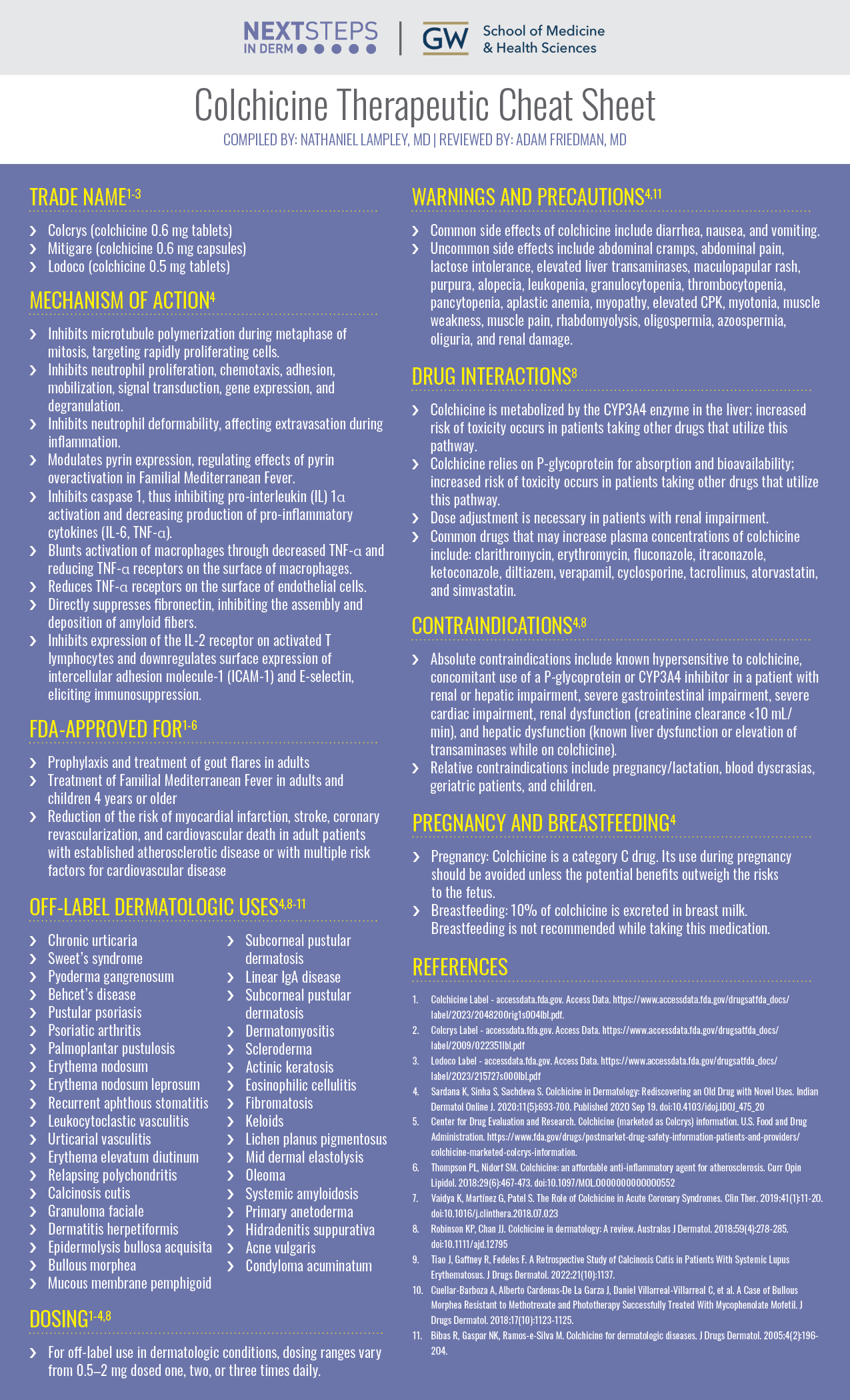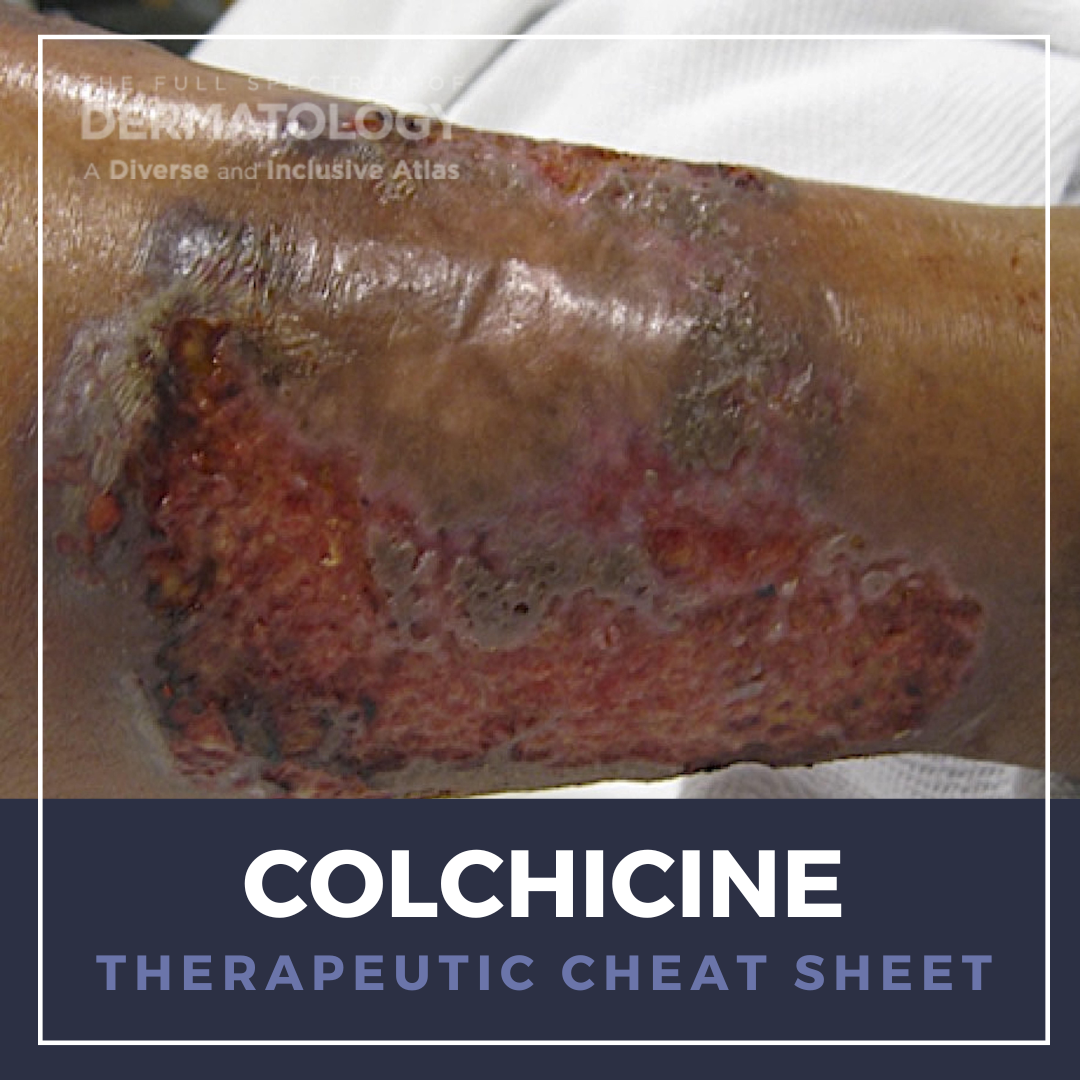Colchicine, a microtubule polymerization inhibitor, was first described for use in treating joint pain and swelling in ancient Egypt and has since become a mainstay in the medical management of gout. Beyond its indicated uses, it has numerous off-label dermatologic applications, particularly for neutrophilic and autoimmune conditions. As a potent anti-inflammatory, colchicine requires careful lab monitoring due to potential adverse effects, especially in patients with renal or hepatic impairment or those on CYP3A4 or P-glycoprotein inhibitors. We continue our series, “Therapeutic Cheat Sheet,” with a closer look at the dermatologic applications of colchicine, which is FDA-approved for the prophylaxis and treatment of gout flares, treatment of Familial Mediterranean Fever, and cardiovascular risk reduction.
Colchicine Therapeutic Cheat Sheet
Compiled by: Nathaniel Lampley, MD | Reviewed by: Adam Friedman, MD
TRADE NAME1-3
-
- Colcrys (colchicine 0.6 mg tablets)
- Mitigare (colchicine 0.6 mg capsules)
- Lodoco (colchicine 0.5 mg tablets)
MECHANISM OF ACTION4
-
- Inhibits microtubule polymerization during metaphase of mitosis, targeting rapidly proliferating cells.
- Inhibits neutrophil proliferation, chemotaxis, adhesion, mobilization, signal transduction, gene expression, and degranulation.
- Inhibits neutrophil deformability, affecting extravasation during inflammation.
- Modulates pyrin expression, regulating effects of pyrin overactivation in Familial Mediterranean Fever.
- Inhibits caspase 1, thus inhibiting pro-interleukin (IL) 1β activation and decreasing production of pro-inflammatory cytokines (IL-6, TNF-ɑ).
- Blunts activation of macrophages through decreased TNF‑α and reducing TNF‑α receptors on the surface of macrophages.
- Reduces TNF‑α receptors on the surface of endothelial cells.
- Directly suppresses fibronectin, inhibiting the assembly and deposition of amyloid fibers.
- Inhibits expression of the IL‑2 receptor on activated T lymphocytes and downregulates surface expression of intercellular adhesion molecule‑1 (ICAM‑1) and E‑selectin, eliciting immunosuppression.
FDA-APPROVED FOR1-6
-
- Prophylaxis and treatment of gout flares in adults
- Treatment of Familial Mediterranean Fever in adults and children 4 years or older
- Reduction of the risk of myocardial infarction, stroke, coronary revascularization, and cardiovascular death in adult patients with established atherosclerotic disease or with multiple risk factors for cardiovascular disease
OFF-LABEL DERMATOLOGIC USES4,8-11
-
- Chronic urticaria
- Sweet’s syndrome
- Pyoderma gangrenosum
- Behcet’s disease
- Pustular psoriasis
- Psoriatic arthritis
- Palmoplantar pustulosis
- Erythema nodosum
- Erythema nodosum leprosum
- Recurrent aphthous stomatitis
- Leukocytoclastic vasculitis
- Urticarial vasculitis
- Erythema elevatum diutinum
- Relapsing polychondritis
- Calcinosis cutis
- Granuloma faciale
- Dermatitis herpetiformis
- Epidermolysis bullosa acquisita
- Bullous morphea
- Mucous membrane pemphigoid
- Subcorneal pustular dermatosis
- Linear IgA disease
- Subcorneal pustular dermatosis
- Dermatomyositis
- Scleroderma
- Actinic keratosis
- Eosinophilic cellulitis
- Fibromatosis
- Keloids
- Lichen planus pigmentosus
- Mid dermal elastolysis
- Oleoma
- Systemic amyloidosis
- Primary anetoderma
- Hidradenitis suppurativa
- Acne vulgaris
- Condyloma acuminatum
DOSING1-4,8
-
- For off-label use in dermatologic conditions, dosing ranges vary from 0.5–2 mg dosed one, two, or three times daily.
WARNINGS AND PRECAUTIONS4
-
- Colchicine overdose can be fatal at doses exceeding 0.8 mg/kg. Severe adverse reactions can occur at doses of 0.5 to 0.8 mg/kg.
- Vitamin B12 activity may be decreased by colchicine, secondary to reversible malabsorption, causing a predisposition to megaloblastic anemia.
SIDE EFFECTS4,11
-
- Common side effects of colchicine include diarrhea, nausea, and vomiting.
- Uncommon side effects include abdominal cramps, abdominal pain, lactose intolerance, elevated liver transaminases, maculopapular rash, purpura, alopecia, leukopenia, granulocytopenia, thrombocytopenia, pancytopenia, aplastic anemia, myopathy, elevated CPK, myotonia, muscle weakness, muscle pain, rhabdomyolysis, oligospermia, azoospermia, oliguria, and renal damage.
DRUG INTERACTIONS8
-
- Colchicine is metabolized by the CYP3A4 enzyme in the liver; increased risk of toxicity occurs in patients taking other drugs that utilize this pathway.
- Colchicine relies on P-glycoprotein for absorption and bioavailability; increased risk of toxicity occurs in patients taking other drugs that utilize this pathway.
- Dose adjustment is necessary in patients with renal impairment.
- Common drugs that may increase plasma concentrations of colchicine include: clarithromycin, erythromycin, fluconazole, itraconazole, ketoconazole, diltiazem, verapamil, cyclosporine, tacrolimus, atorvastatin, and simvastatin.
CONTRAINDICATIONS4,8
-
- Absolute contraindications include known hypersensitive to colchicine, concomitant use of a P-glycoprotein or CYP3A4 inhibitor in a patient with renal or hepatic impairment, severe gastrointestinal impairment, severe cardiac impairment, renal dysfunction (creatinine clearance <10 mL/min), and hepatic dysfunction (known liver dysfunction or elevation of transaminases while on colchicine).
- Relative contraindications include pregnancy/lactation, blood dyscrasias, geriatric patients, and children.
PREGNANCY AND BREASTFEEDING4
-
- Pregnancy: Colchicine is a category C drug. Its use during pregnancy should be avoided unless the potential benefits outweigh the risks to the fetus.
- Breastfeeding: 10% of colchicine is excreted in breast milk. Breastfeeding is not recommended while taking this medication.

FURTHER READING
If you would like to learn more about colchicine, check out the following articles in the Journal of Drugs in Dermatology:
Treatment of Chronic Urticaria With Colchicine
-
- Pho, M. Eliason, M. Regruto, C. Hull, and D. Powell
ABSTRACT
Background: Chronic urticaria (CU) is a cutaneous disease that can be debilitating, difficult to treat, and sometimes life-threatening. Treatment with antihistamines is often ineffective. Immunosuppressants are second line therapy but can have significant side effects. Data is needed on effective therapies with safer profiles.
Objectives: To determine the efficacy and side-effects of colchicine in patients with CU. Methods: Patients were identified through retrospective chart reviews at the University of Utah from 2002-2007. We identified 36 patients with a diagnosis of chronic urticaria based on history, physical examination, and a skin biopsy. Length of treatment ranged from one month to 17 months.
Results: Subjective clinical responses to colchicine therapy reported as complete (n=15) or partial (n=5) were found in 56 percent of patients. The mean±SD duration of treatment was 7±6 months. Three patients (15%) who had resolution of urticaria stopped colchicine secondary to diarrhea and hematuria. Of the complete responders, nine individuals (60%) have remained symptom free and four individuals (27%) had recurrence after colchicine was stopped.
Limitations: Short-term follow-up and retrospective study design.
Conclusions: This retrospective study demonstrated that colchicine was an effective and well-tolerated treatment for patients unresponsive to antihistamines. The data supports the use of colchicine for CU patients and further controlled studies are warranted to better characterize the use of colchicine in patients with CU refractory to antihistamines.
Colchicine for dermatologic diseases
-
- Bibas, N. Kalil Gaspar, and M. Ramos-e-Silva
ABSTRACT
The authors review all aspects related to colchicine from its pharmacology to its usage in several skin diseases
References
-
- Colchicine Label – accessdata.fda.gov. Access Data. https://www.accessdata.fda.gov/drugsatfda_docs/label/2023/204820Orig1s004lbl.pdf.
- Colcrys Label – accessdata.fda.gov. Access Data. https://www.accessdata.fda.gov/drugsatfda_docs/label/2009/022351lbl.pdf
- Lodoco Label – accessdata.fda.gov. Access Data. https://www.accessdata.fda.gov/drugsatfda_docs/label/2023/215727s000lbl.pdf
- Sardana K, Sinha S, Sachdeva S. Colchicine in Dermatology: Rediscovering an Old Drug with Novel Uses. Indian Dermatol Online J. 2020;11(5):693-700. Published 2020 Sep 19. doi:10.4103/idoj.IDOJ_475_20
- Center for Drug Evaluation and Research. Colchicine (marketed as Colcrys) information. U.S. Food and Drug Administration. https://www.fda.gov/drugs/postmarket-drug-safety-information-patients-and-providers/colchicine-marketed-colcrys-information.
- Thompson PL, Nidorf SM. Colchicine: an affordable anti-inflammatory agent for atherosclerosis. Curr Opin Lipidol. 2018;29(6):467-473. doi:10.1097/MOL.0000000000000552
- Vaidya K, Martínez G, Patel S. The Role of Colchicine in Acute Coronary Syndromes. Clin Ther. 2019;41(1):11-20. doi:10.1016/j.clinthera.2018.07.023
- Robinson KP, Chan JJ. Colchicine in dermatology: A review. Australas J Dermatol. 2018;59(4):278-285. doi:10.1111/ajd.12795
- Tiao J, Gaffney R, Fedeles F. A Retrospective Study of Calcinosis Cutis in Patients With Systemic Lupus Erythematosus. J Drugs Dermatol. 2022;21(10):1137.
- Cuellar-Barboza A, Alberto Cardenas-De La Garza J, Daniel Villarreal-Villarreal C, et al. A Case of Bullous Morphea Resistant to Methotrexate and Phototherapy Successfully Treated With Mycophenolate Mofetil. J Drugs Dermatol. 2018;17(10):1123-1125.
- Bibas R, Gaspar NK, Ramos-e-Silva M. Colchicine for dermatologic diseases. J Drugs Dermatol. 2005;4(2):196-204.
Did you enjoy this Therapeutic Cheat Sheet? You can find more here.

